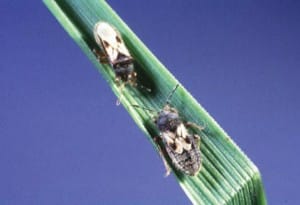
Chinch bugs usually grow to no more than 1/8″ in length. While it may be difficult to think of such small pests as a threat to your lawn, a look at their reproductive habits makes their dangerous potential very clear.
Up to seven generations of chinch bugs are possible per season, with adults laying up to 300 eggs during their short lifespan. So, millions of chinch bugs could be feasting on your lawn at any given time this summer.
Signs of damage
Chinch bugs use their beak-like mouths to suck plant juices from the nodes and crowns of turfgrass plants. At the same time, they inject a toxin into the plants that can prove fatal to turf. Turf damage usually appears as patchy dead spots, most commonly found along driveways, sidewalks and curbs. The extent of turfgrass damage depends on the population of the chinch bugs, as well as on the general vigor of the lawn.
Prevention
Chinch bug outbreaks are often seen in turf that gets excessive nitrogen fertilizer. Fertilizing only when necessary, and using a slow-release, low-nitrogen fertility program, will help to reduce the risk of over-fertilization. This will make turf less attractive to chinch bugs. In addition, chinch bugs thrive in hot, dry conditions, so it’s important to keep your turf well-watered during the summer. Finally, proper mowing and regular aeration will help to prevent chinch bug infestations as well.
If chinch bugs do make their presence known, prompt treatment with an insecticide will be necessary to prevent major damage from occurring. For more information on chinch bugs, give GroGreen a call today.
Existing customer? Log In

